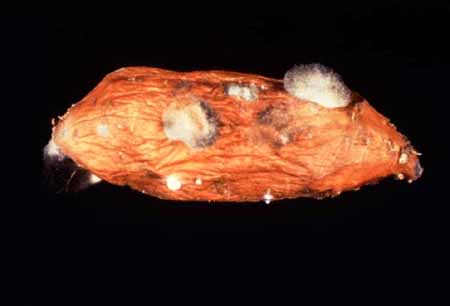|

Web-like
outgrowth on storage root (W. Martin, APS).
|
Diagnostic summary
-
water-soaked lesions develop
after storage root has been wounded or bruised during harvest or handling.
-
lesions become covered by a web-like outgrowth with scattered
pinhead-like structures.
-
entire inner tissues of the root rot become soft, slimy and watery
as they liquefy. However, periderm remains almost intact except for small
cracks and wrinkled appearance.
-
black brush-like domes with whisker-like appearance emerge from
periderm cracks.
|
Taxonomy
Economic
importance
Geographical
distribution
Morphology
Symptoms
Biology
and ecology
Host
range
Detection
Management
References
View full fact sheet
|

